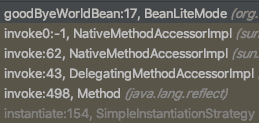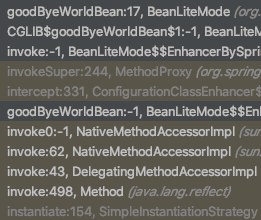
bean lite mode란 무엇인가
bean annotation 문서를 보던 도중, bean lite mode라는 키워드를 봤습니다. 검색해보니 이와 반대되는 친구로는 bean full mode가 있는데요.
bean full mode의 경우에는 우리가 평소 사용하는 방식입니다.(Configuration 어노테이션에 별도 설정없이 사용) 그렇다면 bean lite mode는 무엇이고, 어떻게 설정하고, 무슨 용도로 사용되는걸까요?
bean lite mode란
bean lite mode는 'inter-bean references'를 지원하지 않고 그 이외에는 bean full mode와 동일하게 동작한다고 합니다. 즉, 동일하게 bean으로 등록되고 bean lifecycle과 관련된 콜백들이 똑같이 호출됩니다.(자세한 내용은 링크를 확인해주세요.)
bean lite mode 설정 방법
bean lite mode는 Configuration 어노테이션의 proxyBeanMethods를 false로 설정하거나 Configuration 이외의 클래스에서 bean 메소드를 작성하면 됩니다.
@Configuration(proxyBeanMethods = false)
public class Test {
@Bean
public HelloWorldBean helloWorldBean() {
return new HelloWorldBean();
}
public class HelloWorldBean implements InitializingBean {
@Override
public void afterPropertiesSet() throws Exception {
System.out.println("hello world!");
}
}
}2021-03-17 21:01:26.794 INFO 5612 --- [ restartedMain] j.LocalContainerEntityManagerFactoryBean : Initialized JPA EntityManagerFactory for persistence unit 'default'
hello world!
2021-03-17 21:01:27.468 INFO 5612 --- [ restartedMain] o.s.s.concurrent.ThreadPoolTaskExecutor : Initializing ExecutorService 'applicationTaskExecutor'위와 같이 정상적으로 빈이 등록되고, hello world! 메세지가 출력된 것을 확인할 수 있습니다.
inter-bean references을 지원하지 않는다는게 무슨 뜻일까?
goodByeWorldBean이 빈으로 등록되는 과정에서 어떤 문자열을 출력할까요?
@Configuration(proxyBeanMethods = true)
public class BeanLiteMode {
@Bean
public HelloWorldBean helloWorldBean() {
return new HelloWorldBean();
}
@Bean
public GoodByeWorldBean goodByeWorldBean() {
GoodByeWorldBean a = new GoodByeWorldBean(helloWorldBean());
GoodByeWorldBean b = new GoodByeWorldBean(helloWorldBean());
if(a.getHelloWorldBean() == b.getHelloWorldBean()) {
System.out.println("same reference");
} else {
System.out.println("different reference");
}
return a;
}
public class HelloWorldBean implements InitializingBean {
@Override
public void afterPropertiesSet() throws Exception {
System.out.println("hello world!");
}
}
public class GoodByeWorldBean {
private HelloWorldBean helloWorldBean;
public GoodByeWorldBean(HelloWorldBean helloWorldBean) {
this.helloWorldBean = helloWorldBean;
}
public HelloWorldBean getHelloWorldBean() {
return helloWorldBean;
}
}
}결과는 'same reference'를 출력합니다. 여기서 proxyBeanMethods = true를 false로 바꾸면 'different reference'가 출력되는 것을 확인할 수 있습니다.
즉, spring에서는 bean scope가 singleton이고 bean full mode(proxyBeanMethods = true)인 경우에는 proxy를 이용하여 bean 메소드가 호출될 때 해당 객체가 singleton임을 보장합니다.
즉 우리가 직접 bean 메소드를 호출했던 것을 getBean 메소드를 통해 bean을 얻을 수 있도록 바꿔줍니다. bean lite mode에서는 이를 보장하지 않습니다.
따라서 bean lite mode에서는 이로 인해 찾기 어려운 버그가 발생할 수 있습니다.
그러면 bean lite mode를 사용 안하면 되지 않나?
bean lite mode를 사용하면 성능 상의 이점을 얻을 수 있습니다.

bean lite mode의 call stack과

bean full mode의 call stack을 보시면 차이가 있다는 것을 알 수 있는데요. proxy 생성을 위한 비용 및 호출할 때 단계가 줄어들어 bean 생성을 좀 더 빠르게 할 수 있습니다.
spring boot에서도 startup 시간을 개선하기 위해 autoconfigure 패키지에서 다음과 같이 bean lite mode를 사용하고 있습니다. (이와 관련된 깃헙 이슈는 해당 링크를 참고해주세요.)
// org.springframework.boot.autoconfigure.web.servlet.DispatcherServletAutoConfiguration
@AutoConfigureOrder(Ordered.HIGHEST_PRECEDENCE)
@Configuration(proxyBeanMethods = false)
@ConditionalOnWebApplication(type = Type.SERVLET)
@ConditionalOnClass(DispatcherServlet.class)
@AutoConfigureAfter(ServletWebServerFactoryAutoConfiguration.class)
public class DispatcherServletAutoConfiguration {
//...
}결론
규모가 큰 프로젝트이고, bean 초기화 및 생성으로 인해 startup에 걸리는 시간이 크다면 bean lite mode 사용을 고려해보는 것도 나쁘지 않을 것으로 보입니다.
그 이외의 경우라면 찾기 어려운 버그를 발생시킬 수 있는 bean lite mode 대신 bean full mode를 사용하는 것이 좋습니다.